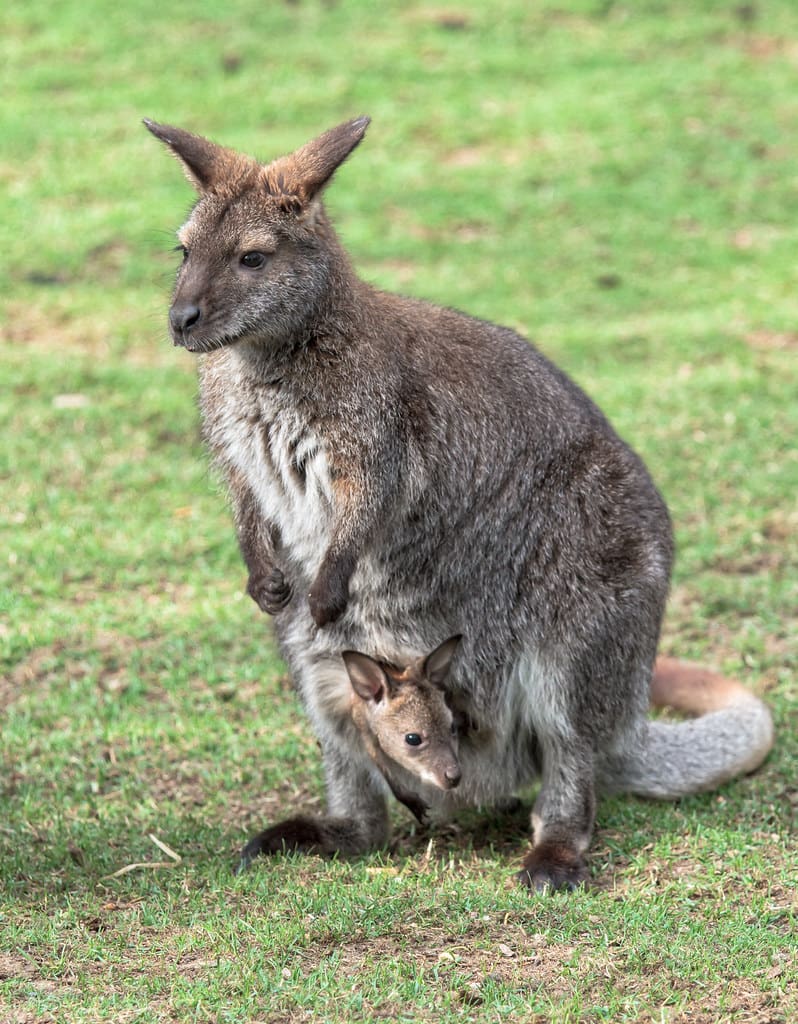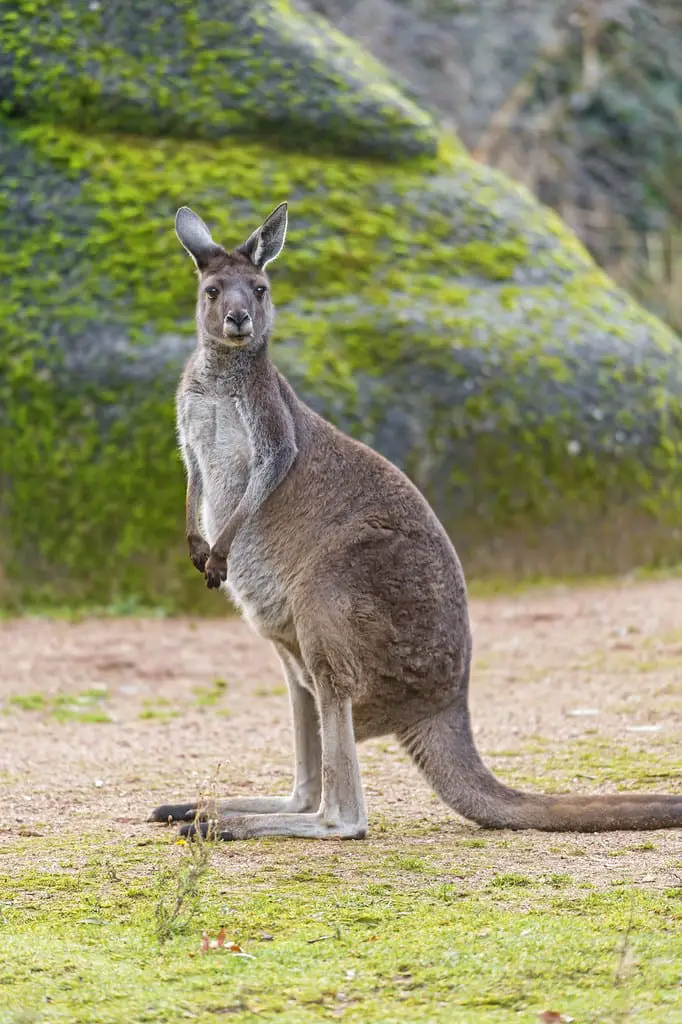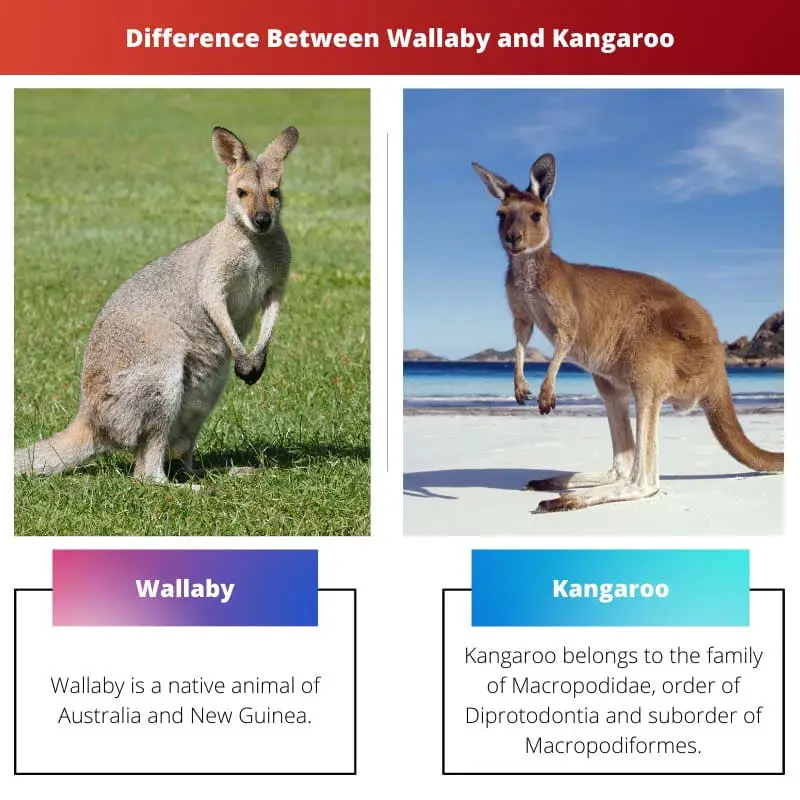Australia reminds people of Wallabies and Kangaroos. Both animals belong to the Macropod family. People confuse between the two animals because they resemble each other and are found in similar places.
But both animals have distinct differences and features.
Key Takeaways
- Wallabies possess a smaller body size than kangaroos, making them more adaptable to dense forests and rugged terrains.
- Wallabies exhibit a more diverse color palette in their fur, including shades of brown, grey, and red, while kangaroos have a more uniform grey-brown coat.
- Wallabies have a diet consisting mainly of leaves and vegetation, whereas kangaroos consume grasses primarily, reflecting their different habitats.
Wallaby vs Kangaroo
Wallabies are smaller than kangaroos, with a more slender build, shorter legs, are more solitary and tend to be found in forests and woodlands. Kangaroos are much larger and more robust than wallabies, with long, powerful hind legs, and are commonly found in open grasslands and savannas.

Kangaroos have longer legs which give them a better height. Kangaroos reach up to a height of 2 meters or more. They have stronger legs that seem disproportionately sized and can carry the young ones at speed. Kangaroos move the fastest in large open terrains.
On the other hand, Wallabies have shorter legs, and they grow up to a height of 1 meter or more. The legs of wallabies have high agility and move the fastest across the floors of forest or rocky escarpments. Wallaby belongs to the genus of Notamacropus.
Comparison Table
| Parameters of Comparison | Wallaby | Kangaroo |
|---|---|---|
| Size | Shorter and smaller | Larger and bigger |
| Fur color | The fur coat has a combination of two to three colors | The fur coat has a uniform muted color which is brown or grey |
| Teeth type | Wallaby has flat teeth and has cutting tooth and premolars | Kangaroo has curved teeth and no premolars |
| Eating habits | Leaves | Grass |
| Life span | Shorter life span and live up to 11 to 14 years | Longer life span and live up to 20 to 25 years, and some have even lived up to 30 years |
What is Wallaby?
Wallaby is a native animal of Australia and New Guinea. The small or middle-sized macropod is also common in other places like New Zealand, the United Kingdom, Hawaii, and several other places.
Wallaby belongs to the genus of Notamacropus. It has 9 species, out of which one has become extinct.
The animal belongs to the family of Kangaroos. Wallabies have a body length of 50 to 110 centimetres and have a tail of 35 to 75 centimetres long. Some species of wallabies even have a horny spur at the tip of the tail.
The animal is widely haunted and sold for meat and fur. Wallaby has powerful hind legs which can bound at high speeds and jump from greater heights. The legs play a major role in kicking off potential predators.
The tail of Wallabies is powerful and it helps the animal to balance and support. The name wallaby has been derived from Dharug “walabi” or Waliba.
Around the 1800s, the term was also used to refer to Brush kangaroo. Some young Wallabies are also called “joeys”. While adult male Wallabies are known as “bucks”, “jacks”, or “boomers.
The adult female Wallabies are termed “Jill’s”, “does”, or “Flyers”, and a group of Wallabies is known as a “mob”, “troupe”, or “court”. The animal is a herbivore and feeds on a wide range of leaves; the grass is vegetables and other foliage.
The various threats to Wallabies are federal dogs and cats, Dingoes, Red foxes, and human predators, which have led to a considerable decrease in the population of Wallabies.

What is Kangaroo?
Kangaroo belongs to the family of Macropodidae, order of Diprotodontia and suborder of Macropodiformes. The hind legs of Kangaroos are large and powerful and are adapted for leaping.
The presence of a long muscular tail is for balance, and the head is small. The female kangaroos have a marsupium pouch; there, the joeys complete their postnatal development.
The kangaroo has specialized teeth. The incisors of the animal can chop the grass adjacent to the ground. And the molars further help in grinding the grass effectively.
The animal does not have both sides of the lower jaw adhered or fused, which gives an area for a wider bite, and the placement of the lower incisors is also farther apart.
The grass has silica, which is an abrasive type, so the kangaroo molars move forward in the mouth. This leads them to fall off gradually, and new teeth replace them later and grow back in the same area.
This leads to a process which is commonly known as polyphyodonty. This process is observed only in elephants and manatees.
The kangaroo is known as a symbol of Australia. The animal is present on the coat of arms of Australia and even on the currency of the country.
Kangaroo is also used as a logo for various organizations in Australia. Kangaroos are also hunted on a large scale for meat, coat, leather hides, and sometimes even to protect the land from grazing.

Main Differences Between Wallaby and Kangaroo
- Wallabies are smaller and weigh around 20 kg, while Kangaroos are larger and weigh around 90 kg.
- The coat of the wallaby is prettier and has a combination of two to three colors while the coat of the kangaroo is uniform and has muted colors like brown or grey.
- Wallabies have no cultural interaction and collaboration with other nations, while Kangaroos are considered as a symbol of Australia.
- The legs of Wallaby are short and compact, while the legs of Kangaroo ate long and oversized.
- Wallaby has premolars and cutting teeth, while Kangaroo has no premolars.


I have gained valuable insights into the behaviors and habitats of Wallabies and Kangaroos from this article. The detailed descriptions are highly informative and engaging.
The comparison table is particularly helpful in understanding the contrasts between Wallabies and Kangaroos. This article provides essential knowledge about these animals.
I appreciate the wealth of knowledge provided in this article about Wallabies and Kangaroos. The profound insights and detailed descriptions are truly enlightening.
This article provides a comprehensive comparison between Wallabies and Kangaroos, from their physical differences to their eating habits. This is truly fascinating. Thank you for sharing.
I appreciate the detailed information presented in this article. The similarities and differences between Wallabies and Kangaroos are clearly outlined, and it has deepened my knowledge about these unique animals.
The article highlights the distinct features and characteristics of Wallabies and Kangaroos, shedding light on their differences and importance in Australia’s ecosystem. Very well written.
This article presents a thorough examination of Wallabies and Kangaroos, offering valuable information about these iconic Australian animals. The detailed descriptions are commendable.
The article offers an impressive comparison between Wallabies and Kangaroos, addressing their distinct differences. It’s evident that these animals play a vital role in Australia’s biodiversity.
The comprehensive details about the physical features and habitats of Wallabies and Kangaroos have provided a greater understanding of these unique animals. An excellent read.
Thank you for the very informative article. It’s very enlightening to learn about the differences between Wallaby and Kangaroo, both native to Australia. I now have a deeper understanding of these two animals.
The in-depth explanations about the natural characteristics and behaviors of Wallabies and Kangaroos have significantly broadened my understanding. This article is enriching and enlightening.
Reading this article has expanded my understanding of the unique physical attributes and behaviors of Wallabies and Kangaroos. It’s a well-researched and informative piece.